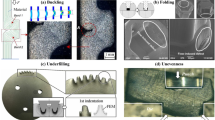Abstract
In microforming process, flow-induced defects caused by the irrational material flow in forming process have a significant effect on the quality of micro-formed part. In design of micropart and microforming process, this type of defects needs to be analyzed and the formation mechanism identified, such that the defects can be predicted and avoided via the rational design of micro-formed parts and microforming process. To address this issue, the size effect affected flow, and deformation behaviors need to be investigated. To explore how the size effects affect the flow-induced defects, experimental studies on the influence of a few significant parameters including geometry and grain sizes on the degree of flow-induced defects in microforming process of pure copper were conducted in this research. The flow-induced defects in microforming of a designed part are investigated, and the microstructure and flow pattern in micro-scaled extrusion of the parts with complicated shape are also studied. Based on the experimental results, the formation of folding defects is mainly affected by geometry size. The folding defect-free deformation occurs in the cases with coarse grains such that the parts with coarse grains do not have flow-induced defects, but some grains are broken and become potential insecurity factor. Furthermore, the relationship between grain and geometry sizes under which the flow-induced defects and grain broken can be successfully and simultaneously avoided is identified.
Similar content being viewed by others
References
Geiger M, Kleiner M, Eckstein R, Tiesler N, Engel U (2001) Microforming. CIRP Annal-Manuf Technol 50:445–462
Engel U, Eckstein R (2002) Microforming—from basic research to its realization. J Mater Process Technol 125:35–44
Fu MW, Luo ZJ (1995) The simulation of the viscoplastic forming process by the finite-element method. J Mater Process Technol 55:442–447
Fu MW, Shang BZ (1995) Stress analysis of the precision forging die for a bevel gear and its optimal design using the boundary-element method. J Mater Process Technol 53:511–520
Vollertsen F, Biermann D, Hansen HN, Jawahir IS, Kuzman K (2009) Size effects in manufacturing of metallic components. CIRP Annal-Manuf Technol 58:566–587
Chan WL, Fu MW, Lu J, Liu JG (2010) Modeling of grain size effect on micro deformation behavior in micro-forming of pure copper. Mater Sci Eng A 527:6638–6648
Chan WL, Fu MW (2012) Studies of the interactive effect of specimen and grain sizes on the plastic deformation behavior in microforming. Int J Adv Manuf Technol
Wang CJ, Shan DB, Zhou J, Guo B, Sun LN (2007) Size effects of the cavity dimension on the microforming ability during coining process. J Mater Process Technol 187:256–259
Ike H (2003) Surface deformation vs. bulk plastic deformation—a key for microscopic control of surfaces in metal forming. J Mater Process Technol 138:250–255
Diehl A, Engel U, Geiger M (2010) Influence of microstructure on the mechanical properties and the forming behaviour of very thin metal foils. Int J Adv Manuf Tech 47:53–61
Chan WL, Fu MW (2011) Experimental studies and numerical modeling of the specimen and grain size effects on the flow stress of sheet metal in microforming. Mater Sci Eng A 528:7674–7683
Messner A, Engel U, Kals R, Vollertsen F (1994) Size Effect in the Fe-simulation of micro-forming Pprocesses. J Mater Process Technol 45:371–376
Shan DB, Wang CJ, Guo B, Wang XW (2009) Effect of thickness and grain size on material behavior in micro-bending. T Nonferr Metal Soc 19:S507–S510
Siopis MS, Kinsey BL (2010) Experimental Investigation of grain and specimen size effects during electrical-assisted forming. J Manuf Sci E-T Asme: 132
Geiger M, Messner A, Engel U (1997) Production of microparts—size effects in bulk metal forming, similarity theory. Prod Eng 4:55–58
Fu MW, Chan WL (2013) A review on the state-of-the-art microforming technologies. Int J Adv Manuf Tech 67:2411–2437
Chan WL, Fu MW, Yang B (2012) Experimental studies of the size effect affected microscale plastic deformation in micro upsetting process. Mater Sci Eng A 534:374–383
Chan WL, Fu MW, Lu J (2011) Experimental and simulation study of deformation behavior in micro-compound extrusion process. Mater Des 32:525–534
Balendra R, Qin Y (2000) Identification and classification of flow-dependent defects in the injection forging of solid billets. J Mater Process Technol 106:199–203
Arentoft M, Wanheim T (1997) The basis for a design support system to prevent defects in forging. J Mater Process Technol 69:227–232
Lee DJ, Kim DJ, Kim BM (2003) New processes to prevent a flow defect in the combined forward–backward cold extrusion of a piston-pin. J Mater Process Technol 139:422–427
Chan WL, Fu MW, Lu J (2010) FE Simulation-based folding defect prediction and avoidance in forging of axially symmetrical flanged components. J Manuf Sci E-T Asme: 132
Wang JL, Fu MW, Ran JQ (2013) Analysis and avoidance of flow-induced defects in meso-forming process: simulation and experiment. Int J Adv Manuf Technol: 1-14
Petrov P, Perfilov V, Stebunov S (2006) Prevention of lap formation in near net shape isothermal forging technology of part of irregular shape made of aluminium alloy A92618. J Mater Process Technol 177:218–223
Fu MW, Luo ZJ (1992) The prediction of macro-defects during the isothermal forging process by the rigid viscoplastic finite-element method. J Mater Process Technol 32:599–608
Rosochowski A, Presz W, Olejnik L, Richert M (2007) Micro-extrusion of ultra-fine grained aluminium. Int J Adv Manuf Technol 33:137–146
Parasiz SA, Krishnan N, Li M, Cao J, Kinsey B (2006) Investigation of deformation size effects during microextrusion. J Manuf Sci Eng 129:690–697
Chan WL, Fu MW, Yang B (2011) Study of size effect in micro-extrusion process of pure copper. Mater Des 32:3772–3782
Author information
Authors and Affiliations
Corresponding author
Rights and permissions
About this article
Cite this article
Wang, J.L., Fu, M.W. & Ran, J.Q. Analysis of size effect on flow-induced defect in micro-scaled forming process. Int J Adv Manuf Technol 73, 1475–1484 (2014). https://doi.org/10.1007/s00170-014-5947-8
Received:
Accepted:
Published:
Issue Date:
DOI: https://doi.org/10.1007/s00170-014-5947-8




